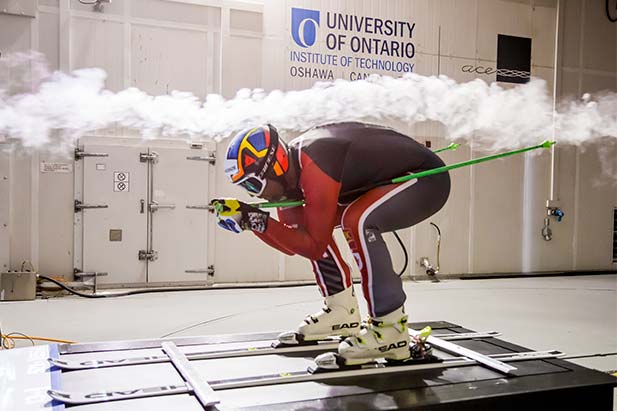Dressed for success: ACE helping tailor Canada’s perfect (alpine ski) suit
University's climatic wind tunnel the ideal venue to test high-performance sport fabrics
February 6, 2018

Many months before Canada’s Winter Olympic team headed to South Korea for the 2018 Games, the alpine ski team was doing a lot of homework inside the ACE Climatic Wind Tunnel at the University of Ontario Institute of Technology. Putting in time to learn how to save time, if you will.
In ski race competitions like the downhill, Super-G and slalom, aerodynamics are incredibly important. Earning a medal or a place on the podium can come down to a hundredth or even a thousandth of a second.
While proper technique and top-line equipment are critical for success in competition, the air resistance—or ‘drag’—of an athlete’s ski suit has the potential to help shave (or add) crucial microseconds on race day. Alpine Canada knows it requires an investment of many research hours to unlock ways of discovering how to help athletes save such tiny amounts of time on the slopes.
For its capacity to deliver consistent and exacting weather conditions replicating temperature, wind and humidity, Alpine Canada and performance wear partner Qwixskinz turned to the ACE Climatic Wind Tunnel in early October. Company founders Deanna Panting and Jeremy Peterson are in the business of designing skin suits with technical sport fabrics. They brought several members of the national team to ACE, dressing them up in the latest gear to be buffeted with race-like 130 kilometre-an-hour winds in front of the wind tunnel nozzle.
The textured (dimpled) fabrics were tested for fit and performance. While computers compiled the fine numbers, a smoke gun swirled a smoke curve around the skiers to demonstrate the behaviour of the airflow visually. The data helped Qwixskinz zero-in on which clothing was fastest. After each test, using sewing machines and thread, the company readjusted each athlete’s individual suit to ensure optimal aerodynamics..
Recent media coverage:
- Toronto Star (December 31, 2017)
- Daily Planet, Discover Channel Canada (January 30, 2018; video segment begins at 1:05 in the time code, runs 4;41))
Canadian alpine ski team athletes who tested at ACE:
*will compete at the Olympics



